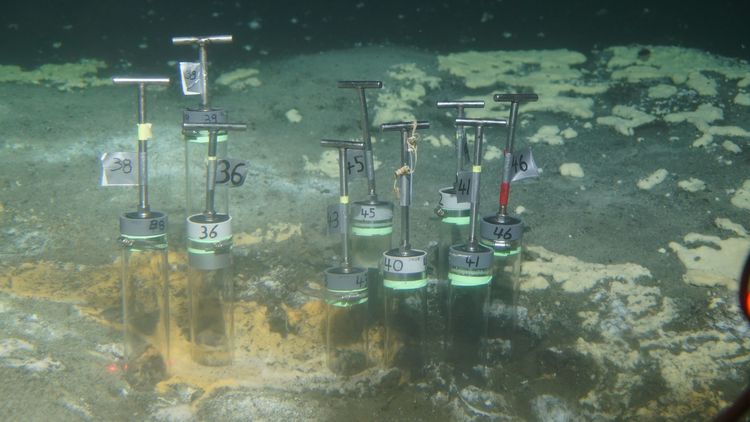What is the role of dissolved organic matter in the deep sea? In a study relating to this question, researchers from the Universities of Bremen and Oldenburg have investigated the composition of dissolved organic matter (DOM) in detail. Their samples were obtained during an expedition to the Guaymas Basin in the Gulf of California.
The Guaymas Basin is an active tectonic basin with hydrothermal vents that is known for its natural oil discharge sites, where microorganisms use the seeping oil as a source of energy and nutrition, and thereby fuel the carbon cycle. Because microorganisms preferentially break down water-soluble organic molecules, it is important to understand how hydrothermal processes mobilize DOM, for example, those from natural oil seeps. Research on these underlying processes, however, has been largely lacking so far.
Analyses carried out by the team have revealed that the composition of the released water-soluble organic molecules, or DOM, is strongly influenced by the temperature of the hydrothermal systems and the composition of the petroleum.
Their results indicate that hydrothermal sediments are a source of bioavailable organic molecules, which are compounds that can be relatively rapidly broken down microbially. But they are also a source of more stable complex DOM compounds that release water-soluble petroleum compounds into the deep sea that are presumably broken down more slowly, according to the study. It has now been published in the journal Limnology and Oceanography. As a result, these hydrothermal systems probably have an influence not only on local ecosystems, but also on much wider regions of the deep sea. The study therefore highlights the need for more quantitative research on the contribution of hydrothermal sediments to the DOM cycle, especially in the deep sea but also to the overall oceanic cycle in general. In addition, the Guaymas Basin could be a source for what is known as black carbon. These kinds of long-lived carbon compounds do not degrade significantly and their origin is not yet completely understood.
Participants in the study from MARUM – Center for Marine Environmental Sciences at the University of Bremen included Dr. Florence Schubotz, and first author Jonas Brünjes who is now at the University of Toronto (Canada), Dr. Michael Seidel from the Institute for Chemistry and Biology of the Marine Environment (ICBM) at the University of Oldenburg, and Prof. Andreas Teske of the University of North Carolina (USA).
Deciphering the sources and sinks for dissolved organic matter and its quantitative significance in the marine carbon cycle is also an integral element within the Cluster of Excellence “Ocean Floor - Earth's Uncharted Interface”, within the framework of which the study was supported.
Original publication:
Jonas Brünjes, Florence Schubotz, Andreas Teske, Michael Seidel: Molecular composition of dissolved organic matter from young organic-rich hydrothermal deep-sea sediments. Limnology and Oceanography 2025. DOI: https://doi.org/10.1002/lno.12812
MARUM produces fundamental scientific knowledge about the role of the ocean and the ocean floor in the total Earth system. The dynamics of the ocean and the ocean floor significantly impact the entire Earth system through the interaction of geological, physical, biological and chemical processes. These influence both the climate and the global carbon cycle, and create unique biological systems. MARUM is committed to fundamental and unbiased research in the interests of society and the marine environment, and in accordance with the Sustainable Development Goals of the United Nations. It publishes its quality-assured scientific data and makes it publicly available. MARUM informs the public about new discoveries in the marine environment and provides practical knowledge through its dialogue with society. MARUM cooperates with commercial and industrial partners in accordance with its goal of protecting the marine environment.
The Institute for Chemistry and Biology of the Marine Environment (ICBM) is an interdisciplinary Institute at the University of Oldenburg with locations in Oldenburg and Wilhelmshaven. It is the only university institute in Lower Saxony that covers broad areas of marine sciences, both in research and in teaching. Currently, 26 working groups of various scientific disciplines - including biology, chemistry, physics, mathematics and social sciences - belong to the institute. ICBM operates the Spiekeroog Coastal Observatory and is the home institute of the research vessel SONNE.

![[Translate to English:]](/f/5/_processed_/3/2/csm_ICBM-Logo-transparent-_91fe1c6774.png)
